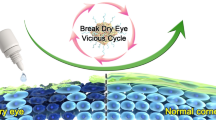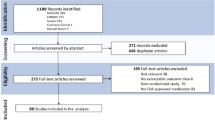Abstract
We examined the effect of L-ascorbic acid 2-phosphate (P-Asc) on the healing of alkali-burned corneas in rabbits. Round filter paper containing 1 N NaOH was applied to the central cornea for 60 or 120 s to produce the alkali burn. Animals were treated with topical saline, 10% ascorbate, or 6.5% P-Asc applied on the cornea. The corneas were then examined histologically. Burned stroma showed no toluidine blue staining, indicating a loss of glycosaminoglycan. In the 60-s burn group, P-Asc reduced the size of the unstained area as compared with the control. Transmission electron microscopy showed basal lamina under new epithelia in the corneas treated with ascorbate or P-Asc, but not in controls. These observations support the theory that P-Asc may have a therapeutic role in the repair of corneal alkali burns.
Similar content being viewed by others
References
Brown SI, Akiya S, Weller CA (1969) Prevention of the ulcers of the alkali-burned cornea: Preliminary studies with collagenase inhibitors. Arch Ophthalmol 82:95–97
Burns FR, Gray RD, Paterson CA (1990) Inhibition of alkaliinduced corneal ulceration and perforation by a thiol peptide. Invest Ophthalmol Vis Sci 31:107–114
Cho H, Covington HI, Cintron C (1990) Immunolocalization of type VI collagen in developing and healing rabbit cornea. Invest Ophthalmol Vis Sci 31:1096–1102
Chung JH, Fagerholm P (1989) Treatment of rabbit corneal alkali wounds with human epidermal growth factor. Cornea 8:122–128
Cintron C, Hong B-S, Kublin CL (1981) Quantitative analysis of collagen from normal developing corneas and corneal scars. Curr Eye Res 1: 1–8
Cintron C, Hong B-S, Covington HI, Macarak EJ (1988) Heterogeneity of collagens in rabbit cornea: type III collagen. Invest Ophthalmol Vis Sci 29:767–775
DiMattio J (1992) Ascorbic acid entry into cornea of rat and guinea pig. Cornea 11: 53–65
Donshik PC, Berman MB, Dohlman CH, Gage J, Rose J (1978) Effect of topical corticosteroids on ulceration in alkali-burned corneas. Arch Ophthalmol 96:2117–2120
Fini ME, Matsubara M, Zieske JD, Cintron C, Girard MT, Kublin CL (1991) Type IV collagenase expression in normal cornea and healing corneal wound. Invest Ophthalmol Vis Sci 32 [Suppl]:1070
Fujisawa K, Katakami C, Yamamoto M (1991) Keratocyte activity during wound healing of alkali-burned cornea. Acta Soc Ophthalmol Jpn 95:59–66
Hata R, Senoo H (1989)l-ascorbic acid 2-phosphate stimulates collagen accumulation, cell proliferation, and formation of a three-dimensional tissuelike substance by skin fibroblasts. J Cell Physiol 138:8–16
Johnson-Wint B (1991) In vivo endogenous regulation of interstitial collagenase production in a mild alkali burn model in rabbit. Invest Ophthalmol Vis Sci 32 [Suppl]:1070
Matsubara M, Mouldovan A, Cui T, Fisher SJ, Galardy R, Fini ME (1991) Activity of type IV collagenase produced by corneal cells after thermal burn. Invest Ophthalmol Vis Sci 32 [Suppl]:1070
Matsubara M, Zieske JD, Fini ME (1991) Mechanism of basement membrane dissolution preceding corneal ulceration. Invest Ophthalmol Vis Sci 32:3221–3237
Matsuda H, Smelser GK (1973) Epithelium and stroma in alkali-burned corneas. Arch Ophthalmol 89:396–401
Newsome DA, Gross J (1977) Prevention by medroxyprogesterone of perforation in the alkali-burned rabbit cornea: inhibition of collagenolytic activity. Invest Ophthalmol Vis Sci 16:21–31
Nomura H, Ishiguro T, Morimoto S (1969) Studies onl-ascorbic acid derivatives. III. Bis-(l-ascorbic acid-3, 3′)-phosphate andl-ascorbic acid 2-phosphate. Chem Pharm Bull [Tokyo] 17:387–393
Ono M, Aratani Y, Kitagawa I, Kitagawa Y (1990) Ascorbic acid phosphate stimulates type IV collagen synthesis and accelerates adipose conversion of 3T3-L1 cells. Exp Cell Res 187:309–314
Pahlitzsch T, Sinha P (1985) The alkali burned cornea: electron microscopical, enzyme histochemical, and biochemical observations. Graefe's Arch Clin Exp Ophthalmol 223:278–286
Pfister RR, Burstein N (1976) The alkali burned cornea. 1. Epithelial and stromal repair. Exp Eye Res 23:519–535
Pfister RR, Paterson CA (1977) Additional clinical and morphological observations on the favorable effect of ascorbate in experimental ocular alkali burns. Invest Ophthalmol Vis Sci 16:478–487
Pfister RR, Paterson CA (1980) Ascorbic acid in the treatment of alkali burns of the eye. Ophthalmology 87:1050–1057
Pfister RR, Paterson CA, Hayes SA (1978) Topical ascorbate decreases the incidence of corneal ulceration after experimental alkali burns. Invest Ophthalmol Vis Sci 17:1019–1024
Pfister RR, Nicolaro ML, Paterson CA (1981) Sodium citrate reduces the incidence of corneal ulcerations and perforations in extreme alkali-burned eyes: acetylcystein and ascorbate have no favorable effect. Invest Ophthalmol Vis Sci 21:486–490
Pfister RR, Haddox JL, Paterson CA (1982) The efficacy of sodium citrate in the treatment of severe alkali burns of the eye is influenced by the route of administration. Cornea 1: 205–211
Saika S (1992) Ultrastructural effect of L-ascorbic acid 2-phosphate on cultured keratocytes. Cornea 11:439–445
Saika S (1993) Ascorbic acid and proliferation of cultured rabbit keratocytes. Cornea: (in press)
Saika S, Kanagawa R, Uenoyama K, Hiroi K, Hiraoka J (1991)l-ascorbic acid 2-phosphate, a phosphate derivative ofl-ascorbic acid, enhances the growth of cultured rabbit keratocytes. Graefes Arch Clin Exp Ophthalmol 229:79–83
Saika S, Uenoyama K, Horoi K, Ooshima A (1992)l-ascorbic acid 2-phosphate enhances the production of types I and III collagen peptides in cultured keratocytes. Ophthalmic Res 24:68–72
Slansky HH, Bermann MB, Dohlman CH, Rose J (1970) Cysteine and acetylcysteine in the prevention of corneal ulcerations. Ann Ophthalmol 2:488–491
Author information
Authors and Affiliations
Rights and permissions
About this article
Cite this article
Saika, S., Uenoyama, K., Hiroi, K. et al. Ascorbic acid phosphate ester and wound healing in rabbit corneal alkali burns: Epithelial basement membrane and stroma. Graefe's Arch Clin Exp Ophthalmol 231, 221–227 (1993). https://doi.org/10.1007/BF00918845
Received:
Accepted:
Issue Date:
DOI: https://doi.org/10.1007/BF00918845




